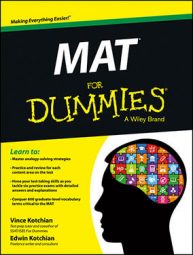Preparing for a test as important as the MAT takes time, so it’s a good idea to have a study plan. Studying for the MAT, you’ll find, takes a plan that involves more than just randomly plunging into some practice material.
After all, you have a lot on the line — your test score is one of many aspects of your graduate school application, but it’s a pretty important one and can make the difference between your earning a place in the program of your choice and having to apply all over again next year.
To make your preparation for the MAT more organized, efficient, and effective, you should figure out where you currently stand and then set a realistic goal.
Figure out where you currently stand on MAT preparation
The first step in goal setting is awareness. Being aware of reality allows you to make the most intelligent decisions, regardless of the situation.
For the MAT, it’s no different. To develop a realistic goal, you need to know where you stand right now. If you’ve already taken the MAT, use your most recent score as a baseline. If you haven’t, you can take a practice test and score it. That number is your starting point.
Even if the score is lower than you want it to be, at least you have a realistic view of your ability at this point in time.
Set a realistic goal for an MAT score
Next, decide what score you want. Also decide who’s determining your goal: Do you have a personal ambition to get a 600, a perfect score? Or are you aiming for the score range accepted by the school to which you’re applying?
A crucial step in the process of deciding what score you want is answering one big question: Why? To answer this question, it’s helpful to meditate on what your MAT score will help you obtain. Is it admission to a certain graduate school program? If so, why do you want to go to that particular program? What exactly do you hope to achieve after you complete that program?
Write the answers to these questions. The clearer your vision is of where you want to go, the more you’ll stoke your motivational fires — and revving up your motivation can make all the difference when you’re disciplining yourself to study again and again.
Whatever your goal is, it’s important to be realistic. If you got 80 questions correct out of 120, improving to 100 out of 120 is probably more realistic than getting to 115 out of 120, especially since the MAT covers such a broad array of content.
The time you’ll have to prepare is a factor, too: If you have just a few weeks to prepare, shooting for a modest improvement is a lot more realistic than trying for a major one.
When you’re ready to choose a goal score, write the number — the exact number — down, and put it where you can see it every day. Having frequent reminders about your goal will keep you motivated and focused, and making the number concrete will give you a specific target to aim for.
Of course, the goal score you write down isn’t set in stone; you may make slower or faster progress toward your goal than you initially thought, and that’s okay. You can always just set a new goal.
Check in with your goal once you’re about a third of the way closer to your test date to see if it needs to be revised.
Set an MAT deadline and map out a schedule
Getting things done usually progresses more slowly unless you have some sort of time limit. So even if you’re not 100% sure about your timeframe for graduate school, set a deadline for completing your studying. If you’ve already registered for the test, you already have your deadline. If not, you need to think about how much time you need to prepare.
This timeline depends on several factors, including your desired program’s application deadline, how much free time you have to study, and how familiar you are right now with major content areas.
When in deadline doubt, give yourself a little padding to keep things realistic. Life has a funny way of throwing unforeseen obstacles at you. And it never hurts to give yourself more time to learn content.
Okay, you have all your action steps and your deadline. It’s time to schedule everything! Whether you use a notebook planner or schedule everything online doesn’t matter — you just need a visual record of your study activity.
If you’re not naturally a planner, or if you just like to go with the flow, this step may feel difficult. But persist. Staying organized with a schedule makes completing all your needed study tasks much easier.
Try working backwards from your test date to schedule tasks. For example, what will you do the day before the test and the week before? Then, keep working backward until you’re back to the current week.
When you wake up and see MAT studying on the day’s schedule, actually doing the studying becomes almost as easy as brushing your teeth and doing your laundry. Okay, maybe that’s an exaggeration, but you get the idea. Making MAT preparation part of your routine makes it easier to achieve your goal.
Now that you’ve planned, set a deadline, and scheduled your practice, only one task remains: As Nike says, “Just Do It.”

